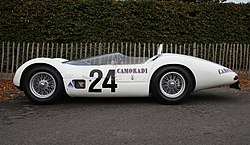
Maserati S.p.A. is an Italian luxury vehicle manufacturer. Established on 1 December 1914 in Bologna, Italy, the company's headquarters are now in Modena, and its emblem is a trident. The company has been owned by Stellantis since 2021. Maserati was initially associated with Ferrari. In May 2014, due to ambitious plans and product launches, Maserati sold a record of over 3,000 cars in one month. This caused them to increase production of the Quattroporte and Ghibli models. In addition to the Ghibli and Quattroporte, Maserati offers the Maserati GranTurismo and two SUV models, the Maserati Levante and the Maserati Grecale. Maserati has placed a yearly production output cap at 75,000 vehicles globally.
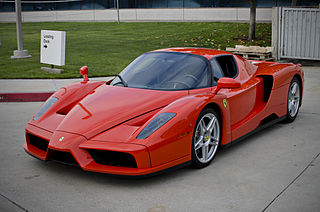
The Ferrari Enzo, officially marketed as Enzo Ferrari, is a mid-engine sports car manufactured by Italian automobile manufacturer Ferrari and named after the company's founder, Enzo Ferrari. It was developed in 2002 using Formula One technology, such as a carbon-fibre body, F1-style automated-shift manual transmission, and carbon fibre-reinforced silicon carbide (C/SiC) ceramic composite disc brakes, as well as technologies not allowed in F1, such as active aerodynamics. The Enzo generates substantial amounts of downforce through its front underbody flaps, small adjustable rear spoiler and rear diffuser, which work in conjunction to produce 3,363 newtons (756 lbf) of downforce at 200 km/h (124 mph) and 7,602 newtons (1,709 lbf) of downforce at 300 km/h (186 mph), before decreasing to 5,738 newtons (1,290 lbf) at top speed.
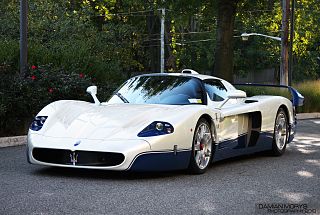
The Maserati MC12 is a limited production two-seater sports car produced by Italian car maker Maserati to allow a racing variant to compete in the FIA GT Championship. The car entered production in 2004, with 25 cars produced. A further 25 were produced in 2005 after the FIA changed the rules and reduced the maximum length allowed. The second batch of 25 are 150mm shorter than the originals, making a total of 50 cars available for customers. With the addition of 12 cars produced for racing, a total of just 62 were ever produced.

Itala was a car manufacturer based in Turin, Italy, from 1904 to 1934, started by Matteo Ceirano and five partners in 1903.

The 1960 24 Hours of Le Mans was the 28th 24 Hours of Le Mans Grand Prix of Endurance, and took place on 25 and 26 June 1960, on Circuit de la Sarthe. It was the fifth and final round of the F.I.A. World Sports Car Championship as well as being the fifth round of the inaugural FIA GT Cup. It was held just a week after the tragic Belgian F1 GP in which two drivers were killed and Stirling Moss and another driver were seriously injured. The prospect of a duel between the 3-litre (180 cu in) Ferrari versus the 2-litre (120 cu in) Porsche championship-leaders was enough to draw large crowds to the 24 Hours race and some 200,000 spectators had gathered for Europe's classic sports car race, around the 13.5 km (8.4 mi) course.
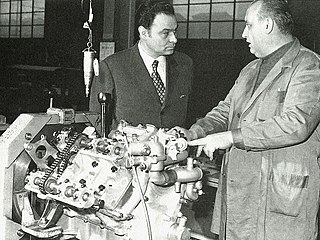
Giulio Alfieri was an Italian automobile engineer, affiliated with Maserati in Modena, Italy since 1953, where he was central to the development of racing and production cars in the 1950s, 1960s and 1970s.

The Maserati 250F was a racing car made by Maserati of Italy used in '2.5 litre' Formula One racing between January 1954 and November 1960. Twenty-six examples were made.

The Maserati 300S was a racing car produced by Maserati of Italy between 1955 and 1958 to compete in the FIA's World Sportscar Championship. Twenty-six examples were produced.

Maserati A6 were a series of grand tourers, racing sports cars and single seaters made by Maserati of Italy between 1947 and 1956. They were named for Alfieri Maserati and for their straight-six engine.

The Maserati 200S is a racing car made by Italian automobile manufacturer Maserati as a successor to the Maserati A6GCS. 28 cars were made in total. The development of the 200S, codenamed Tipo 52 started in 1952, led by Vittorio Bellentani. In response to Ferrari's 500 Mondial racing car which featured a four-cylinder engine and was quite successful in sports car racing. The car had a 1,994.3 cc (2.0 L) inline-four light-alloy engine, featuring dual overhead valves per cylinder and twin camshafts, double Weber 50DCO3 or 45DCO3 carburetors. The engine was rated at 190 PS at 7,500 rpm. Many chassis components were identical to the Maserati 150S in order to speed up development, except the rigid rear axle inherited from the Maserati A6.

Maserati 150S is a racing car made by Maserati of Italy alongside the Maserati 200S, to take over for the aging Maserati A6GCS racing variants. Depending on the source, between twenty-four and twenty-seven examples were built, and one additional street-going car, called the Maserati 150 GT.

The Maserati Tipo 151 is a racing car manufactured by Italian automobile manufacturer Maserati for the 1962 LeMans season to compete in the experimental GT car class. Three cars were built in total, one for Johnny Simone of Maserati France with a red exterior colour and white tri-stripes whilst two were built for Briggs Cunningham for his racing team. These cars had a white body with two blue stripes.

Casner Motor Racing Division – also known as America Camoradi, Camoradi USA or Camoradi International – was an American racing team of the 1960s known for racing Maserati Birdcage sports cars, and a Porsche and Cooper in Formula One.
Lloyd Perry Casner was an American race car driver and the creator of the Casner Motor Racing Division team.
Throughout its history, the Italian auto manufacturer Maserati has participated in various forms of motorsport including Formula One, sportscar racing and touring car racing, both as a works team and through private entrants. Maserati currently competes in Formula E in partnership with the Monaco Sports Group (MSG) as Maserati MSG Racing.

The Maserati Tipo 26 was a model of Grand Prix racing car and was the first car built by Italian manufacturer Maserati, for a total of 11 examples, between 1926 and 1932.
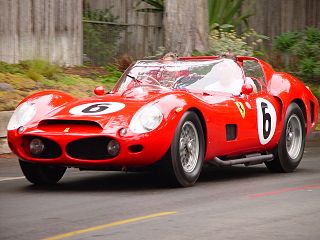
The Ferrari 330 TRI/LM Spyder is a unique racing sports car purpose-built in 1962 by Ferrari to achieve victory at the 24 Hours of Le Mans. It was the last Ferrari racing sports car with a front-mounted engine and the last of a series of Ferrari race cars known as the Testa Rossas. The "I" in its designation indicates that the car has an independent rear suspension.

The Maserati 150 GT was a prototype sports car produced by Maserati in 1957. Derived from the four-cylinder Maserati 150S race car, it was a singular road-going example, and was given spyder bodywork.

The Maserati 420M/58Eldorado was a single-seater manufactured by Maserati in 1958. It was a one-off race car purpose-built for the second edition of the 500 Miles of Monza. It was the first single-seater in Europe to be sponsored by a brand not attached to an automobile industry. The internal Maserati classification was the Tipo 4, behind the 250F variants, and also referred to as the 420/M/58 for 4.2-litre displacement, Monoposto or a single-seater in Italian and 1958 year, or simply as the "Eldorado".
Maserati made four naturally-aspirated, V12 racing engines, designed for Formula One, between 1951 and 1969. The first was an experimental O.S.C.A. engine, in accordance with the 4.5 L engine regulations imposed by the FIA for 1951. Their second engine was 250 F1 V12, in accordance with the 2.5 L engine regulations set by the FIA. Their last two V12 engines were customer engines supplied to Cooper, between 1966 and 1969. The Tipo 9 / F1 and Tipo 10 /F1, which were both manufactured to the FIA's 3.0 L engine regulations for 1966. One sports car, a modified version of the Maserati 350S, also used V12 engine, with a 3.5 L (210 cu in) displacement, and produced 335 hp (250 kW).

